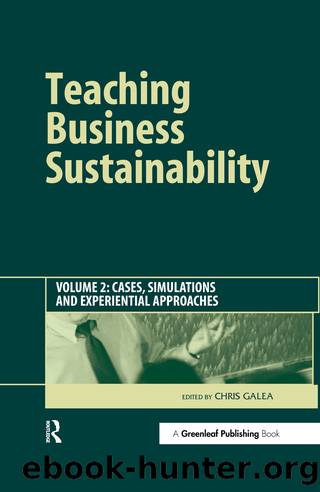Teaching Business Sustainability Vol. 2 by Galea Chris;

Author:Galea, Chris;
Language: eng
Format: epub
Publisher: Taylor & Francis Group
Reasons for the demise
Why did this disaster happen? One explanation is ignorance. Even though they were isolated, the islanders had developed technology that surpassed most other societies of their era.11 Certainly, they were not technically ignorant. The numerous ahu with their elaborately carved statues throughout the island are evidence of an advanced culture. Clearly they were not culturally ignorant. However, if people are not aware of their impact on their environment, then environmental degradation can result especially in growing populations. Polynesian peoples have a long history of being environmentally aware (Orliac and Orliac 1998), so this seems an unlikely explanation on Easter Island. Since the island is not large and each clan apparently had its own land, islanders were probably aware of the diminishing number and size of trees on the island even over their relatively short lifetimes. Also, it is very likely that there would have been a transferable oral tradition that would have indicated increasing difficulties in harvesting wood for its many uses by each succeeding generation.
A second explanation is neglect by individuals, by leaders or by society. When change is gradual and is measured in lifetimes or generations, it is easy to be neglectful. By the time that the change becomes rapid it is often too late for corrective action. On Easter Island the trees gradually became fewer, smaller and, as society adapted, maybe less important. The last palm disappeared around the mid-1400s, yet the real crisis did not appear until a century later by which time it was too late to do anything about the loss of the forest.
Economists frequently focus on the roles played by incentives and self-interest in human decisions. Unlike most Polynesian palms, the palm that was indigenous to Easter Island was a very slow-growing tree. The Jubaea palm normally requires 40â60 years before it reaches the fruit-growing stage and it can take even longer. Brander and Taylor (1998) estimate that the typical lifespan for islanders that survived infancy was around 30 years, so the length of time to tree maturity would have exceeded the lifetimes of virtually all islanders. Consequently, a programme of replanting and caring for seedlings would never have been of direct benefit to the cultivators. It would only benefit their children or grandchildren. Under these conditions the incentives for forest preservation, especially in a growing population, were not adequate. Moreover, even if recognised as a problem, these âincentivesâ were determined by technical considerations (tree and human life expectancy) that would have been very difficult if not impossible to change.
Brander and Taylor (1998) apply a Ricardo-Malthus model of renewable resource use to Easter Island and demonstrate that overshooting and collapse is much more likely for slower-growing tree species than for the more usual faster-growing species. Moreover, they go on to point out that Easter Island did not present a favourable environment for efficient institutional adaptation. While environmentally aware, the islanders probably did not understand the biology of the forestâsoil complex or the incentive effects of alternative institutional arrangements, such as population control or forest preservation.
Download
This site does not store any files on its server. We only index and link to content provided by other sites. Please contact the content providers to delete copyright contents if any and email us, we'll remove relevant links or contents immediately.
The Brazilian Economy since the Great Financial Crisis of 20072008 by Philip Arestis Carolina Troncoso Baltar & Daniela Magalhães Prates(105711)
International Integration of the Brazilian Economy by Elias C. Grivoyannis(75513)
The Art of Coaching by Elena Aguilar(52202)
Flexible Working by Dale Gemma;(23213)
How to Stop Living Paycheck to Paycheck by Avery Breyer(19568)
The Acquirer's Multiple: How the Billionaire Contrarians of Deep Value Beat the Market by Tobias Carlisle(12113)
Thinking, Fast and Slow by Kahneman Daniel(11801)
The Radium Girls by Kate Moore(11626)
The Art of Thinking Clearly by Rolf Dobelli(9929)
Hit Refresh by Satya Nadella(8863)
The Compound Effect by Darren Hardy(8523)
Atomic Habits: Tiny Changes, Remarkable Results by James Clear(8054)
Tools of Titans by Timothy Ferriss(7823)
Turbulence by E. J. Noyes(7708)
Change Your Questions, Change Your Life by Marilee Adams(7384)
A Court of Wings and Ruin by Sarah J. Maas(7273)
Nudge - Improving Decisions about Health, Wealth, and Happiness by Thaler Sunstein(7255)
How to Be a Bawse: A Guide to Conquering Life by Lilly Singh(7161)
Win Bigly by Scott Adams(6831)
